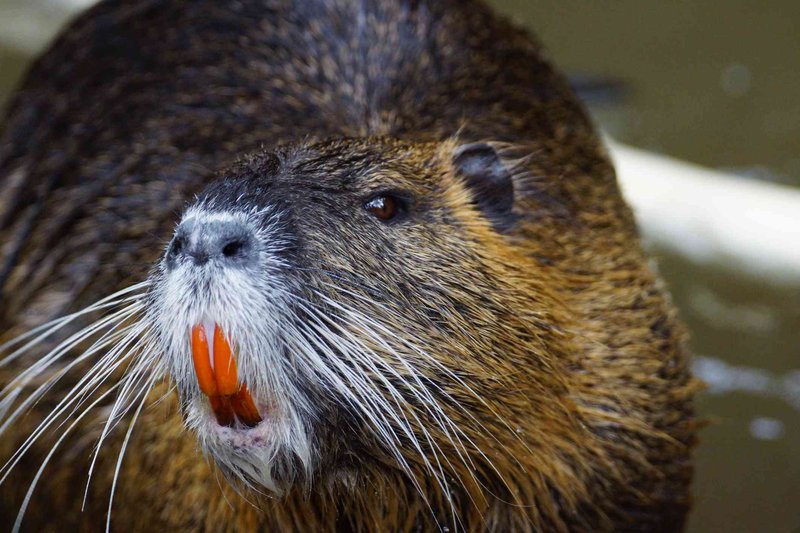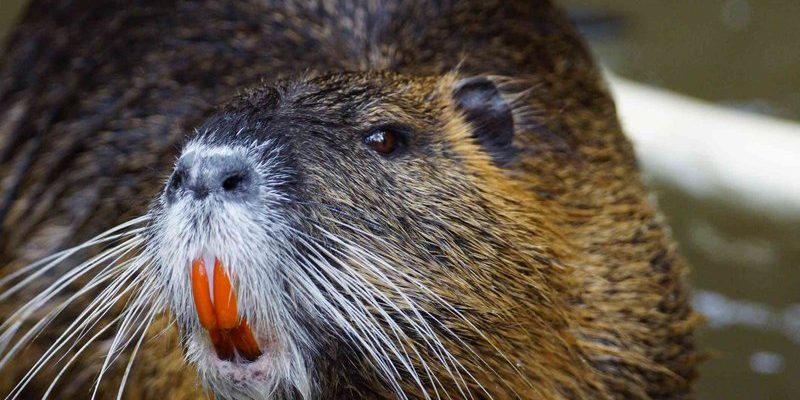
What is a Nutria?
Nutria, often referred to as “coypu,” are semi-aquatic rodents that are native to South America. Imagine a beaver, but leaner and looking a bit more like a giant rat—this is what a nutria resembles. These fascinating creatures are fascinating not just because of their looks but also because of their adaptability to various environments. You can find them in wetlands, rivers, and marshes, where they thrive and play an important role in the ecosystem.
These mammals have a knack for survival, which has allowed them to spread far beyond their native range in South America. First introduced to the United States in the 19th century for their fur, they’ve since become established in many areas, often causing environmental concerns. Nutria are an interesting blend of cute and troublesome, and understanding them can help us appreciate their role in nature while also recognizing the challenges they pose.
Physical Characteristics of Nutria
Nutria are easily recognizable due to their distinctive physical features. They typically weigh between 40 to 60 pounds and measure about 2 to 4 feet in length, including their long, round tails. Their fur is thick, dense, and often brown or grayish in color, providing insulation in cooler waters. Interestingly, they have webbed hind feet, allowing them to swim efficiently—imagine being able to glide through water effortlessly, just like a duck!
One of the most striking features of the nutria is their large orange incisors. You might think they look a bit like a cartoon character with those big, prominent teeth, but they serve a practical purpose. These teeth grow continuously throughout their lives, which means that nutria must gnaw on vegetation to keep them from getting too long. It’s a bit like a very persistent pair of garden shears, always trimming back the growth!
To sum it up, the notable features of nutria include:
| Average Weight: | 40 – 60 pounds |
| Length: | 2 – 4 feet (including tail) |
| Fur Color: | Brown or gray |
| Teeth Color: | Bright orange |
| Habitat: | Wetlands, marshes, rivers |
| Life Span: | Up to 6 years in the wild |
Habitat and Distribution
Nutria love water—it’s their playground. They can be spotted in a variety of wetland environments, including swamps, marshes, and rivers. This adaptability is one of their strengths: they can live in fresh, brackish, or even salty water, which makes them quite versatile. You might be surprised to learn that they can also thrive in more urban environments, as long as there’s a nearby water source.
Originally from South America, where their populations are stable, nutria have expanded their range significantly. They were brought to the United States for fur farming, and from those farms, they escaped or were released into the wild. Nowadays, they’ve adapted well to climates from the Gulf Coast to the Pacific Northwest. It’s interesting how one species can find ways to thrive in so many different settings!
However, their spread has come with challenges. In places where they’ve become overpopulated, nutria can cause significant damage to wetland ecosystems. They are known to consume large amounts of aquatic vegetation, which can lead to erosion and loss of habitat for other wildlife. This creates a ripple effect that can disrupt the entire ecosystem.
Diet and Feeding Habits
When it comes to what nutria eat, they’re quite the herbivores! Their diet primarily consists of aquatic plants, which they love munching on while sitting in the water. Think of them as nature’s lawn mowers; they graze on the grasses and roots along riverbanks and in marshes. Their strong teeth are built for this task, allowing them to efficiently chop through tough vegetation.
Nutria are also known for their ability to consume their own body weight in food each day! This means they can eat anywhere from 2 to 5 pounds of vegetation, which might sound impressive—like a buffet feast every day. They usually feed at dawn and dusk, making them crepuscular, which is just a fancy way of saying they are most active during twilight hours. If you’ve ever watched the early morning sun glint off a river while sipping your coffee, you can picture the nutria grazing happily along the banks.
But here’s the catch: their eating habits can lead to significant ecological issues. As they munch their way through plant life, they can decimate critical habitats for other animals. In some areas, they prefer to eat the same vegetation that supports birds and fish, leading to competition for food and habitat. This is where the balance of nature can easily be tipped!
Behavior and Social Structure
Nutria are social animals, often living in groups known as “herds” or “families.” In these groups, you’ll find a diverse mix of ages, from babies to adults, which creates a vibrant community. This social structure helps them protect each other from predators—after all, there’s strength in numbers. They are also known to communicate through various vocalizations, ranging from soft whistles to loud growls, especially when feeling threatened. It’s like having conversations at dinner but with a lot more squeaking!
One of the most interesting behavioral traits of nutria is their habit of digging burrows. They create these homes near water sources, which helps keep them safe from predators and harsh weather. Imagine living in a cozy little hideaway by a river, where you can pop out for snacks whenever you want—sounds nice, doesn’t it? These burrows often have underwater entrances that provide an escape route from predators like coyotes, alligators, and birds of prey.
Moreover, there’s a nurturing side to nutria. Female nutria are devoted mothers, often giving birth to litters of 4 to 6 young after a gestation period of about 130 days. These little ones are born ready to swim and forage within hours. However, the survival rate can vary depending on environmental conditions and predation pressures. This nurturing behavior ensures the next generation of these unique creatures has a fighting chance.
Ecological Impact of Nutria
You might be wondering, “Why does it matter if nutria are in my area?” Well, their presence can have both positive and negative effects on ecosystems, and it’s a bit of a double-edged sword. On one hand, they are known to help control the growth of aquatic plants, which can be beneficial in maintaining a balanced ecosystem. They contribute to the cycling of nutrients, breaking down organic matter in their habitats.
However, if their population grows too large, nutria can cause significant damage. They are notorious for overgrazing, which can lead to the destruction of habitat for other wildlife. When they eat away at the plant life, it can cause soil erosion and water quality issues, leading to a decline in biodiversity. Imagine a garden where every plant was suddenly uprooted; you can see how this might disrupt the entire environment.
In some regions, local governments have had to take action to manage nutria populations to prevent further ecological damage. This may involve trapping and relocation efforts to ensure balance in the ecosystem. You might see signs warning about nutria in areas where they pose a threat to native species. It’s a reminder of how interconnected nature is and how one species can ripple through an entire system.
Conservation Status and Efforts
Nutria are classified as an invasive species in many areas outside their native habitat. This means that while they may not be endangered, their populations often need to be managed to prevent ecological damage. In the U.S., various state and federal programs aim to control their numbers, focusing on areas where they are especially problematic.
Some conservationists argue that it’s essential to find a balance—while nutria can indeed be harmful to certain ecosystems, they also have their place in the food web. For instance, they provide food for larger predators and help in nutrient cycling through their grazing habits. This complexity highlights the challenges of managing invasive species: it’s not always a simple “remove and replace” situation.
Therefore, when discussing nutria conservation, it’s crucial to focus on effective management strategies that consider ecological health rather than outright eradication. Many organizations engage the public through educational programs to raise awareness about the impacts of nutria and how communities can help manage their populations responsibly.
FAQ
Are nutria dangerous to humans?
Nutria are generally not dangerous to humans. They tend to be shy and avoid direct contact. However, they can carry diseases that may affect humans and pets, so it’s always wise to steer clear if you see them in the wild. Observing from a distance is best, as with any wildlife, to prevent any incidents.
How fast can nutria swim?
Nutria are strong swimmers and can reach speeds of about 5 miles per hour in water. Their webbed feet make them excellent swimmers, allowing them to escape from predators and navigate their aquatic habitats efficiently.
Do nutria have natural predators?
Yes, nutria have several natural predators, including coyotes, alligators, and birds of prey like eagles and hawks. These predators play a role in controlling nutria populations in their native habitats.
How do nutria reproduce?
Nutria are prolific breeders. A female can give birth to a litter of 4 to 6 young after a gestation period of about 130 days. These young are precocial, meaning they are born relatively mature and can swim shortly after birth.
What do nutria eat?
Nutria are herbivores, primarily feeding on aquatic vegetation, roots, and tubers. They are known to consume up to 5 pounds of food daily, which can significantly impact the ecosystems they inhabit.
How long do nutria typically live?
In the wild, nutria typically have a lifespan of about 4 to 6 years. However, in captivity or areas where they are well-managed, they may live longer.
Can nutria be kept as pets?
While some people may consider keeping nutria as pets, they require a lot of space and access to water to thrive. Additionally, they can be destructive and may not be suitable for a typical household setting.
What are the signs of a nutria infestation?
Signs of a nutria infestation include burrows near water sources, chewed vegetation, and flattened grass in feeding areas. You might also notice their droppings or tracks along the banks.
How do officials manage nutria populations?
Officials use various methods to manage nutria populations, including trapping and relocation, as well as public education campaigns to raise awareness about their impact on ecosystems.
Are nutria considered a delicacy in any culture?
Interestingly, in some cultures, nutria meat is considered a delicacy. It has been consumed in various regions, especially where nutria populations are plentiful, like parts of Louisiana.
How do nutria contribute to their ecosystems?
Nutria contribute to nutrient cycling in wetlands and can help control plant growth. However, their overpopulation can lead to habitat destruction, highlighting the need for balanced management strategies.

